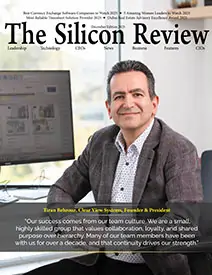50 Most Trustworthy Companies of the Year 2018
A Health Care Company That’s Building a Healthier World: Aetna
The Silicon Review
![]()
Founded in 1853 in Hartford, CT, Aetna is committed to providing individuals, employers, health care professionals, producers, and others with innovative benefits, products, and services. Discover more about our organization.
Aetna serves an estimated 44.6 million people with information and resources to help them make better-informed decisions about their healthcare and has operations in North America, Asia, Europe, and the Middle East.
Aetna Values
Our core values and corporate beliefs drive the decisions we make every day
Simplicity: To us, a better healthcare system starts with a simpler process, one that lets you see behind the scenes — to find out what a procedure costs before you get it, for example.
Focus: A better health care system is about more than saving money, of course. It’s about keeping you healthy. We’re working with doctors, hospitals and health networks to align the economic incentives so everyone’s focus stays on your health.
Connection: Finally, we think a better system is one that is connected. The right technology connects you and your healthcare team seamlessly. And it puts valuable information where it needs to be so you get the right care at the right time.
Integrity. Excellence. Caring. Inspiration.
- Integrity – Do the right thing for the right reason.
- Excellence – We strive to deliver the highest quality and value possible through simple, easy and relevant solutions.
- Caring – We listen to and respect our customers and each other so we can act with insight, understanding, and
- Inspiration – We inspire each other to explore ideas that can make the world a better place.
Walking Down the Memory Line: The Important Milestones
1853: Aetna Insurance Company organized an annuity fund to sell life insurance in 1850. In 1853, the Annuity department separates from Aetna Insurance and is incorporated as Aetna Life Insurance Company. The company's first president is Eliphalet A. Bulkeley. The "Aetna" name is retained to take advantage of the good reputation of the original Aetna. The name was inspired by an 11,000-foot volcano on the eastern shores of Sicily, Mt. Etna, which was the most active volcano in Europe.
1861: Aetna begins offering participating life insurance policies, which paid dividends to policyholders just as the mutuals did, but gave Aetna the ability to better compete in the marketplace. Aetna launches its new product with an aggressive promotional effort, which included higher commission rates for agents. This shift in strategy caught the industry by surprise. With the outbreak of the Civil War, many companies were thinking of retrenching, not expansion. But the devastation of the battlefields combined with a prosperous wartime economy sparked a surge in life insurance purchases.
1899: Aetna becomes one of the first stock insurance companies to enter the health insurance business. The new product was offered only to people holding or purchasing an Aetna life or accident policy.
Aetna begins offering liability coverage. As the nation's industrial base grew more complex, and the Progressive social reform movement gained political momentum, Aetna responds by organizing an Accident and Liability department in 1902 to handle employers' liability and workmen's collective insurance. This department became the cornerstone of the Aetna Accident and Liability Company in 1907. It later added protection against damage to horse teams, flywheel breakage, auto collision coverage, plate glass and burglary insurance, and surety bonds.
1913: Aetna forms a department to sell group life insurance, becoming one of the first insurers to write group coverage for businesses. This became the foundation upon which Aetna built its current healthcare business. The 1900s brought into the public consciousness the notion that employers were responsible for the safety of their workers.
1922: Morgan G. Bulkeley dies after 43 years as Aetna president. Under Bulkeley, Aetna experienced explosive growth. Its assets increased from $25.7 million in 1879 to $207 million, and premium income rose more than twenty-fold. Bulkeley is replaced by his nephew, Morgan B. Brainard. Under Brainard, Aetna revamped its agency system and rewrote its policies in simpler language.
1953: Aetna celebrates its centennial. The gala is attended by more than 8,000 people at the home office. The festivities featured Arthur Fiedler and the Boston Pops Orchestra, Harry James and his big band, Henny Youngman, and a congratulatory note from Vice President Richard M. Nixon. The birthday cake stands over 12 feet tall and weighs more than 200 pounds.
1985: Aetna joins with Voluntary Hospitals of America to form Partners National Health Plans, an alternative delivery healthcare joint venture. Aetna, then the nation's largest private health insurer, entered the 50-50 joint venture to begin marketing HMOs, PPOs, and other competitively priced products. VHA, with over 400 hospitals in 40 states, was the nation's largest not-for-profit multihospital organization.
2003: Aetna celebrates its 150th anniversary. To mark the milestone, Aetna executives ring the Closing Bell at the New York Stock Exchange on June 16. Aetna and physicians begin a new era of cooperation by agreeing to streamline communications, reduce administrative complexity and improve the quality of the health care system, ending litigation between Aetna and 700,000 physicians and medical societies.
Aetna, a leader in addressing health disparities, commits more than $3 million to improve access to care and delivery of health care to its diverse populations. Aetna is the first national, full-service health insurer to announce a health savings account (HSA) option.
Howdy Chief
Mark T. Bertolini, Chairman, and CEO:
Mark T. Bertolini is Chairman and Chief Executive Officer of Aetna Inc., a Fortune 50 diversified health care benefits company with over $63 billion in 2016 revenue. Mr. Bertolini assumed the role of CEO on November 29, 2010, and of Chairman on April 8, 2011.
Prior to joining Aetna, Mr. Bertolini held executive positions at Cigna, NYLCare Health Plans, and SelectCare, Inc., where he served as president and chief executive officer.
Mr. Bertolini holds an undergraduate degree in business administration/finance from Wayne State University and an MBA in finance from Cornell University. In 2017 Mr. Bertolini received an honorary Doctor of Laws from Wayne State University for his distinguished healthcare career and outstanding philanthropic leadership.
_2025-12-15_12-44-58.webp)


_2025-11-17_06-38-14.webp)

 (1)_2025-10-21_13-35-14.webp)
